Experimental Evaluation of the Multiphase Flow Effect on Sand Production Process: Prepack Sand Retention Testing Results
Abstract
:1. Introduction
Field and Reservoir Characterization
- The reservoir is composed of unconsolidated/weakly consolidated sandstone;
- High oil viscosity (67 cP);
- Low reservoir temperature (35 °C);
- Small thickness of the pay zone (10–20 m);
- Presence of aquifer and extensive gas cap;
- Sharp contrast of permeability (100–10,000 mD);
- Active sand production during well operation (Figure 3);
- Low strength properties of the formation.
2. Materials and Methods
- Screen aperture size;
- Drawdown pressure during filtration;
- Oil, water (brine) and gas content of the injected fluid.
- Suspended solids concentration (content) (SSC);
- Relative changes of permeability in the “model-screen” system;
- Particle size distribution of the produced solids.
- 100% “oil”;
- 90%/10% “oil”/brine;
- 50%/50% “oil”/brine;
- 30%/70% “oil”/brine;
- 70%/30% “oil”/gas;
- 50%/50% “oil”/gas;
- 10%/90% “oil”/gas.
- scale effect—the smaller the sample of rock, the less uncertainty in the distribution of rock particles by volume, which directly affects the reservoir properties of the model;
- the ability to “change” the porosity and permeability of the bulk model during its assembly (by changing the amount of force during uniaxial compression), as well as by changing the rock pressure in the filtration facility;
- the ability to saturate bulk models with formation water to the required level.
- First probe was taken from initial liquid flux up to 10 milliliters of liquid (with sand) of volume. Pore volume of the model was estimated to be around 3–4 mL, thus, the first probe contained 2–3 pore volumes of simulated bottomhole formation zone (BHZ), which can be classified as well stimulation stage.
- Second probe was taken immediately after the first one. This stage represents the pseudo-steady state of the flow in the model (reservoir) and also contained 10 mL of liquid (with sand). Given the high permeability of the reservoir and models, that represent it, it is likely that the pseudo-steady flow stage would not last for a long period of time.
- Third probe was taken immediately after the second. This stage represents the “steady” state of the flow and also contained 10 mL of liquid (with sand).
- Fourth probe was the last and it contained all the remaining volume of liquid with sand that was pumped through the model during the experiments. Approximately 250 mL of liquid was gathered at this stage.
- For coupons with openings of 100, 150, and 200 µm SSC was measured using pycnometers (due to the small size of the washed-out particles and their adhesion to filter-paper);
- For coupons with openings of 500 and 700 µm SSC was measured using filter-paper (“Blue ribbon”).
3. Results
4. Discussion
- amount of cementing material in the reservoir rock;
- both physical and chemical processes in the reservoir;
- gas-oil ratio;
- water cut;
- technology, that is used to prevent sanding;
- reservoir drawdown (fluid flowrate) [41];
- completion type.
- Capillary pressure changes;
- Possible interaction in the hydrophilic reservoirs where brine adheres to the surface and this makes it easier for the flow to enthrall particles;
- Possibility of emulsification of the flow, thus, increasing effective viscosity and increasing drag force of the flow.
- The ratio of fluids in the pycnometers corresponds to the given parameters of the test—i.e., during the experiment, water/“oil” 30/70, the ratio of liquids in the pycnometer was taken as such [44];
- Mass of sand that is left in the installation was not measured or evaluated;
- Densities of “oil” and brine were measured once at the beginning of the test.
5. Conclusions
Author Contributions
Funding
Institutional Review Board Statement
Informed Consent Statement
Data Availability Statement
Acknowledgments
Conflicts of Interest
References
- Abram, M.; Cain, G. Particle-Size Analysis for the Pike 1 Project, McMurray Formation. J. Can. Pet. Technol. 2014, 53, 339–354. [Google Scholar] [CrossRef]
- Fattahpour, V.; Mahmoudi, M.; Wang, C.; Kotb, O.; Roostaei, M.; Nouri, A.; Fermaniuk, B.; Sauve, A.; Sutton, C. Comparative Study on the Performance of Different Stand-Alone Sand Control Screens in Thermal Wells. In Proceedings of the SPE International Conference and Exhibition on Formation Damage Control, Lafayette, LA, USA, 6–8 February 2018. [Google Scholar] [CrossRef]
- Romanova, U.; Ma, T. SPE 165111 An Investigation of the Plugging Mechanisms in a Slotted Liner from the Steam Assisted Gravity Operations. In Proceedings of the SPE European Formation Damage Conference & Exhibition, Noordwijk, The Netherlands, 5–7 June 2013; p. 8. [Google Scholar]
- Romanova, U.G.; Gillespie, G.; Sladic, J.; Weatherford, T.M.; Solvoll, T.A.; Andrews, J.S. A Comparative Study of Wire Wrapped Screens vs. Slotted Liners for Steam Assisted Gravity Drainage Operations. In Proceedings of the World Heavy Oil Congress 2014, New Orleans, LA, USA, 5–7 March 2014; p. 24. [Google Scholar]
- Mahmoudi, M.; Fattahpour, V.; Nouri, A. SPE-184999-MS An Experimental Evaluation of Pore Plugging and Permeability Reduction Near SAGD Sand Control Liners. In Proceedings of the SPE Canada Heavy Oil Technical Conference, Calgary, AL, Canada, 15–16 February 2017; pp. 1–18. [Google Scholar]
- Mahmoudi, M.; Fattahpour, V.; Nouri, A.; Yao, T.; Baudet, B.A.; Leitch, M. Oil Sand Characterization for Standalone Screen Design and Large-Scale Laboratory Testing for Thermal Operations. In Proceedings of the SPE Thermal Well Integrity and Design Symposium, Banff, AB, Canada, 23–25 November 2015. [Google Scholar] [CrossRef]
- Mahmoudi, M.; Fattahpour, V.; Nouri, A.; Rasool, S.; Leitch, M. WHOC16-612 The Effect of Screen Aperture Size on Fines Production and Migration in SAGD Production Wells. In Proceedings of the Effect of Screen Aperture Size on Fines Production and Migration in SAGD Production Wells, 2016 World Heavy Oil Congress, Calgary, Al, Canada, 5–8 July 2016; pp. 1–6. Available online: https://www.researchgate.net/publication/307522135 (accessed on 10 October 2021).
- Suman, G.O., Jr.; Ellis, R.C.; Snyder, R.E. Sand Control Handbook, 2nd ed.; Gulf Publishing Company: Houston, TX, USA, 1986. [Google Scholar]
- Garolera, D.; Carol, I.; Papanastasiou, P. Micromechanical analysis of sand production. Int. J. Numer. Anal. Methods Géoméch. 2019, 43, 1207–1229. [Google Scholar] [CrossRef]
- Bianco, L.; Halleck, P. Mechanisms of Arch Instability and Sand Production in Two-Phase Saturated Poorly Consolidated Sandstones. In Proceedings of the SPE European Formation Damage Conference, The Hague, The Netherlands, 21–22 May 2001. [Google Scholar] [CrossRef]
- Papamichos, E.; Malmanger, E.M. A Sand-Erosion Model for Volumetric Sand Predictions in a North Sea Reservoir. SPE Res. Eval. Eng. 2001, 4, 44–50. [Google Scholar] [CrossRef]
- Clearly, M.P.; Jelvan, J.J.; Kohlhaas, C.A. The Effect Of Confining Stress And Fluid Properties On Arch Stability In Unconsolidated Sands. In Proceedings of the Paper presented at the SPE Annual Technical Conference and Exhibition, Las Vegas, NV, USA, 23–26 September 1979; p. 12. [Google Scholar]
- Hall, D.; Div, D.; Harrisberger, W.H. Stability of Sand Arches: A Key to Sand Control. SPE J. Pet. Technol. 1970, 22, 821–829. Available online: http://onepetro.org/JPT/article-pdf/22/07/821/2225169/spe-2399-pa.pdf (accessed on 10 October 2021). [CrossRef]
- Kotb, O.; Haftani, M.; Nouri, A. An Investigation into Current Sand Control Testing Practices for Steam Assisted Gravity Drainage Production Wells. Eng 2021, 2, 435–453. [Google Scholar] [CrossRef]
- Ma, C.; Deng, J.; Dong, X.; Sun, D.; Feng, Z.; Luo, C.; Xiao, Q.; Chen, J. A new laboratory protocol to study the plugging and sand control performance of sand control screens. J. Pet. Sci. Eng. 2019, 184, 106548. [Google Scholar] [CrossRef]
- Fattahpour, V.; Roostaei, M.; Hosseini, S.A.; Soroush, M.; Berner, K.; Mahmoudi, M.; Al-Hadhrami, A.; Ghalambor, A. Experiments with Stand-Alone Sand-Screen Specimens for Thermal Projects. SPE Drill. Complet. 2020, 36, 188–207. [Google Scholar] [CrossRef]
- Cespedes, E.A.M.; Roostaei, M.; Uzcátegui, A.A.; Soroush, M.; Izadi, H.; Hosseini, S.A.; Schroeder, B.; Mahmoudi, M.; Gomez, D.M.; Mora, E.; et al. SPE-199062-MS Sand Control Optimization for Rubiales Field: Trade-Off Between Sand Control, Flow Performance and Mechanical Integrity. In Proceedings of the SPE Latin American and Caribbean Petroleum Engineering Conference, Virtual, 27–31 July 2020; p. 31. [Google Scholar]
- Solovyev, T. SPE-196851-MS Enhancing Efficiency of High-Viscosity Oil Development with Using Autonomous Flow Control Devices Case Study in Western Siberia. In Proceedings of the SPE Russian Petroleum Technology Conference, Moscow, Russia, 22–24 October 2019. [Google Scholar]
- Solovyev, T.; Ivanov, A.; Soltanov, D.; Meshkov, V.; Kamalov, A.; Nagimov, V.; Trusov, A.; Aslanyan, I.; Makarov, D. SPE-201896-MS Smart Completion Improvement in Horizontal Wells Based on Through-Barrier Diagnostics. In Proceedings of the SPE Russian Petroleum Technology Conference, Moscow, Russia, 26–29 October 2020. [Google Scholar]
- Tananykhin, D.; Korolev, M.; Stecyuk, I.; Grigorev, M. An Investigation into Current Sand Control Methodologies Taking into Account Geomechanical, Field and Laboratory Data Analysis. Resources 2021, 10, 125. [Google Scholar] [CrossRef]
- Anderson, M. SPE-185967-MS SAGD Sand Control: Large Scale Testing Result. In Proceedings of the SPE Canada Heavy Oil Technical Conference, Calgary, AL, Canada, 15–16 February 2017; pp. 15–16. [Google Scholar]
- O’Hara, M. Thermal Operations in the McMurray; An Approach to Sand Control. In Proceedings of the SPE Thermal Well Integrity and Design Symposium, London, UK, 23–25 November 2015. [Google Scholar] [CrossRef]
- McPhee, C.; Farrow, C.; McCurdy, P. Challenging Convention in Sand Control: Southern North Sea Examples. SPE Prod. Oper. 2007, 22, 223–230. [Google Scholar] [CrossRef]
- Ballard, T.; Beare, S.; Wigg, N. SPE-178966-MS Sand Retention Testing: Reservoir Sand or Simulated Sand-Does it Matter? In Proceedings of SPE International Conference and Exhibition on Formation Damage Control, Lafayette, LA, USA, 24–26 February 2016; p. 22. [Google Scholar]
- Mahmoudi, M.; Fattahpour, V.; Nouri, A.; Rasoul, S.; Yao, T.; Baudet, B.A.; Leitch, M.; Soroush, M. SPE-182517-MS Investigation Into the Use of Commercial Sands and Fines to Replicate Oil Sands for Large-Scale Sand Control Testing. In Proceedings of the SPE Thermal Well Integrity and Design Symposium, Banff, AL, Canada, 28 November–1 December 2016; pp. 1–23. [Google Scholar]
- Gendler, S.; Fazylov, I. Application efficiency of closed gathering system toward microclimate normalization in operating galleries in oil mines. Min. Inform. Anal. Bull. 2021, 65–78. [Google Scholar] [CrossRef]
- Rogachev, M.; Aleksandrov, A. Justification of a comprehensive technology for preventing the formation of asphalt-resin-paraffin deposits during the production of highlyparaffinic oil by electric submersible pumps from multiformation deposits. J. Min. Inst. 2021, 250, 596–605. [Google Scholar] [CrossRef]
- Chanpura, R.A.; Hodge, R.M.; Andrews, J.S.; Toffanin, E.P.; Moen, T.; Parlar, M. A Review of Screen Selection for Standalone Applications and a New Methodology. SPE Drill. Complet. 2011, 26, 84–95. [Google Scholar] [CrossRef]
- Hodge, R.M.; Burton, R.C.; Constien, V.; Skidmore, V. An Evaluation Method for Screen-Only and Gravel-Pack Completions. In Proceedings of the International Symposium and Exhibition on Formation Damage Control, Lafayette, LA, USA, 20–21 February 2002. [Google Scholar]
- Islamov, S.; Grigoriev, A.; Beloglazov, I.; Savchenkov, S.; Gudmestad, O. Research Risk Factors in Monitoring Well Drilling—A Case Study Using Machine Learning Methods. Symmetry 2021, 13, 1293. [Google Scholar] [CrossRef]
- Palyanitsina, A.; Safiullina, E.; Byazrov, R.; Podoprigora, D.; Alekseenko, A. Environmentally Safe Technology to Increase Efficiency of High-Viscosity Oil Production for the Objects with Advanced Water Cut. Energies 2022, 15, 753. [Google Scholar] [CrossRef]
- Mardashov, D.V. Development of blocking compositions with a bridging agent for oil well killing in conditions of abnormally low formation pressure and carbonate reservoir rocks. Записки Гoрнoгo института 2021, 251, 617–626. [Google Scholar] [CrossRef]
- Sultanbekov, R.; Islamov, S.; Mardashov, D.; Beloglazov, I.; Hemmingsen, T. Research of the Influence of Marine Residual Fuel Composition on Sedimentation Due to Incompatibility. J. Mar. Sci. Eng. 2021, 9, 1067. [Google Scholar] [CrossRef]
- Salahi, A.; Dehghan, A.N.; Sheikhzakariaee, S.J.; Davarpanah, A. Sand production control mechanisms during oil well production and construction. Pet. Res. 2021, 6, 361–367. [Google Scholar] [CrossRef]
- Yim, W.-S. Offshore Quaternary sediments and their engineering significance in Hong Kong. Eng. Geol. 1994, 37, 31–50. [Google Scholar] [CrossRef]
- Zhenzhen, W.; Shanyu, Z.; Xiaodong, D.; Xuewu, W.; Yapanto, L.M.; Raupov, I.R. Multi-criteria decision making approaches to select appropriate enhanced oil recovery techniques in petroleum industries. Energy Rep. 2021, 7, 2751–2758. [Google Scholar] [CrossRef]
- Sheng, J. Critical review of low-salinity waterflooding. J. Pet. Sci. Eng. 2014, 120, 216–224. [Google Scholar] [CrossRef]
- Valdya, R.N.; Fogler, H.S. Fines Migration and Formation Damage: Influence of pH and Ion Exchange. SPE Prod. Eng. 1992, 7, 325–330. [Google Scholar]
- Soroush, M.; Roostaei, M.; Mohammadtabar, M.; Hosseini, S.A.; Mahmoudi, M.; Sadrzadeh, M.; Ghalambor, A.; Fattahpour, V. SPE-201315-MS Design for Reliability: Purpose Driven Sand Control Methods for Cased and Perforated Wells. In Proceedings of the SPE Annual Technical Conference and Exhibition, Virtual, 26–29 October 2020; p. 29. [Google Scholar]
- Adams, P.R.; Davis, E.R.; Hodge, R.M.; Burton, R.C.; Ledlow, L.; Procyk, A.D.; Crissman, S.C. Current State of the Premium Screen Industry: Buyer Beware, Methodical Testing and Qualification Shows You Don’t Always Get What You Paid For. SPE Drill. Completion 2009, 24, 362–372. [Google Scholar] [CrossRef]
- Kozhagulova, A.; Shabdirova, A.; Minh, N.H.; Zhao, Y. An integrated laboratory experiment of realistic diagenesis, perforation and sand production using a large artificial sandstone specimen. J. Rock Mech. Geotech. Eng. 2020, 13, 154–166. [Google Scholar] [CrossRef]
- Ben Mahmud, H.; Leong, V.H.; Lestariono, Y. Sand production: A smart control framework for risk mitigation. Petroleum 2020, 6, 1–13. [Google Scholar] [CrossRef]
- Ikporo, B.; Sylvester, O. Effect of Sand invasion on Oil Well Production: A case study of Garon Field in the Niger Delta. Int. J. Eng. Sci. (IJES) 2015, 4, 64–72. [Google Scholar] [CrossRef]
- Palyanitsina, A.; Tananykhin, D.; Masoud, R. Strategy of water-flooding enhancement for low-permeable polymictic reservoirs. J. Appl. Eng. Sci. 2021, 19, 307–317. [Google Scholar] [CrossRef]
- Aroyehun, M.E. SPE-193526-MS Comparative Study of Sand Control Methods in Selected Niger-Delta Sand Stone Reservoirs. In Proceedings of the SPE Nigeria Annual International Conference and Exhibition, Lagos, Nigeria, 1–3 August 2018. [Google Scholar]


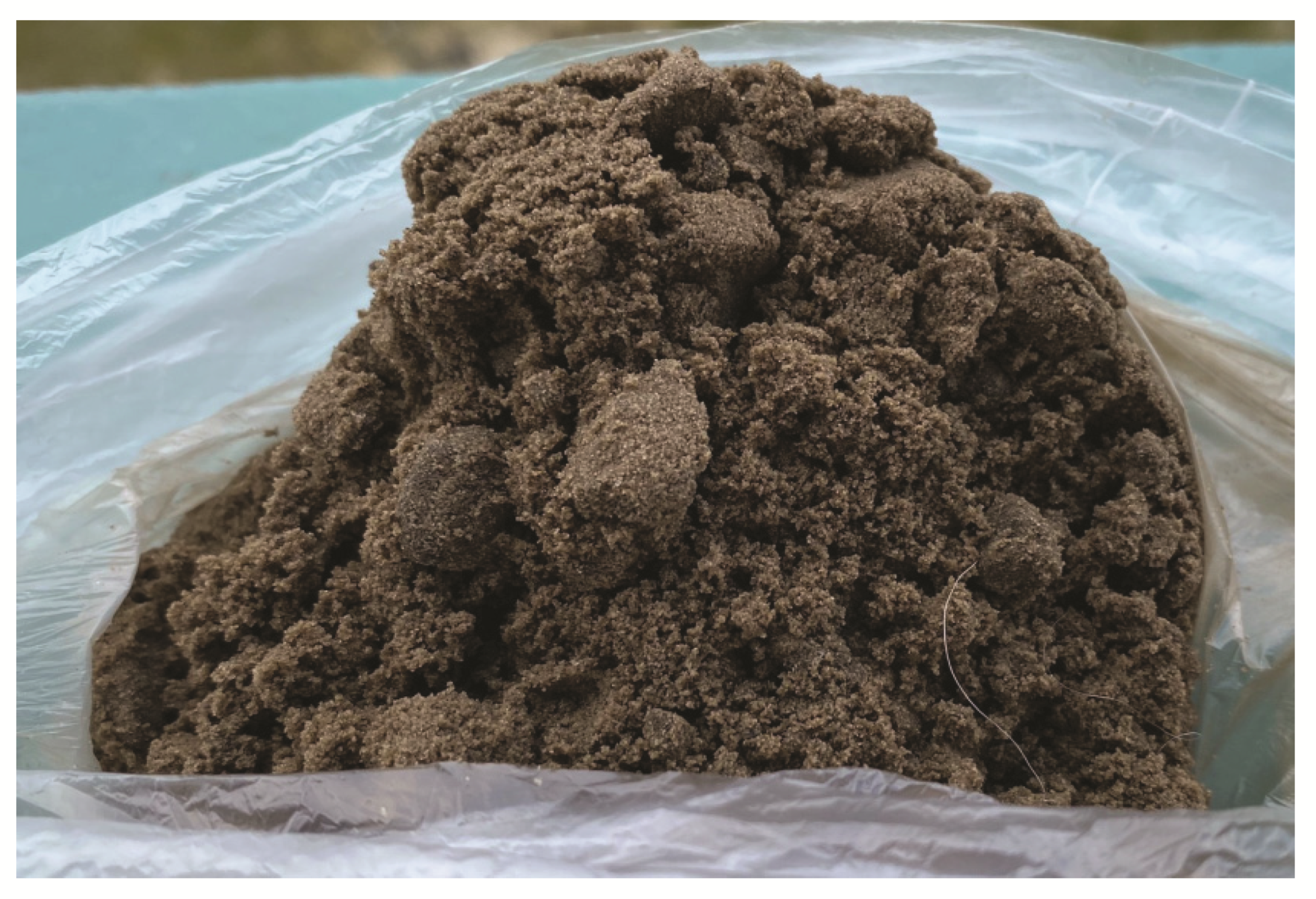
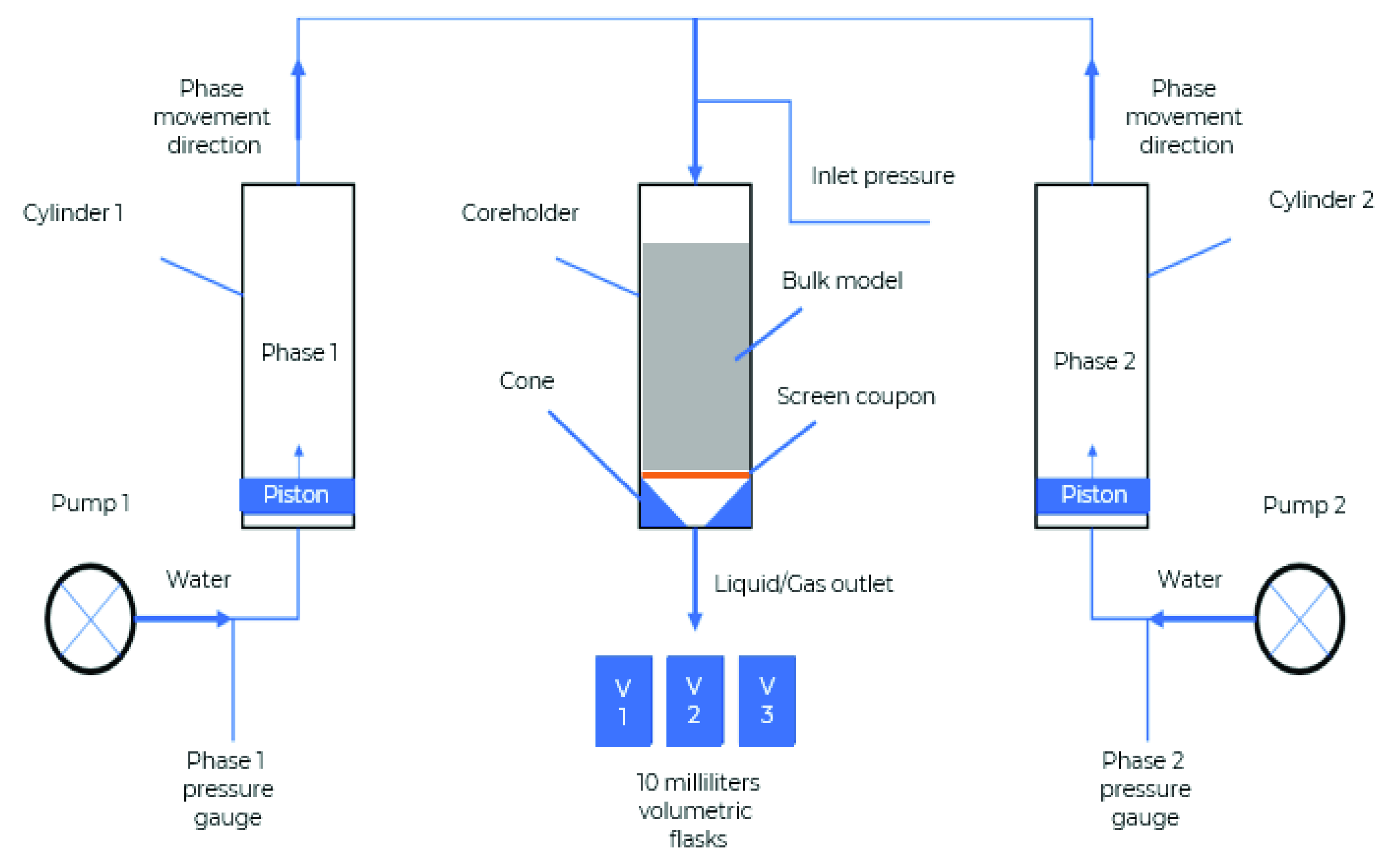
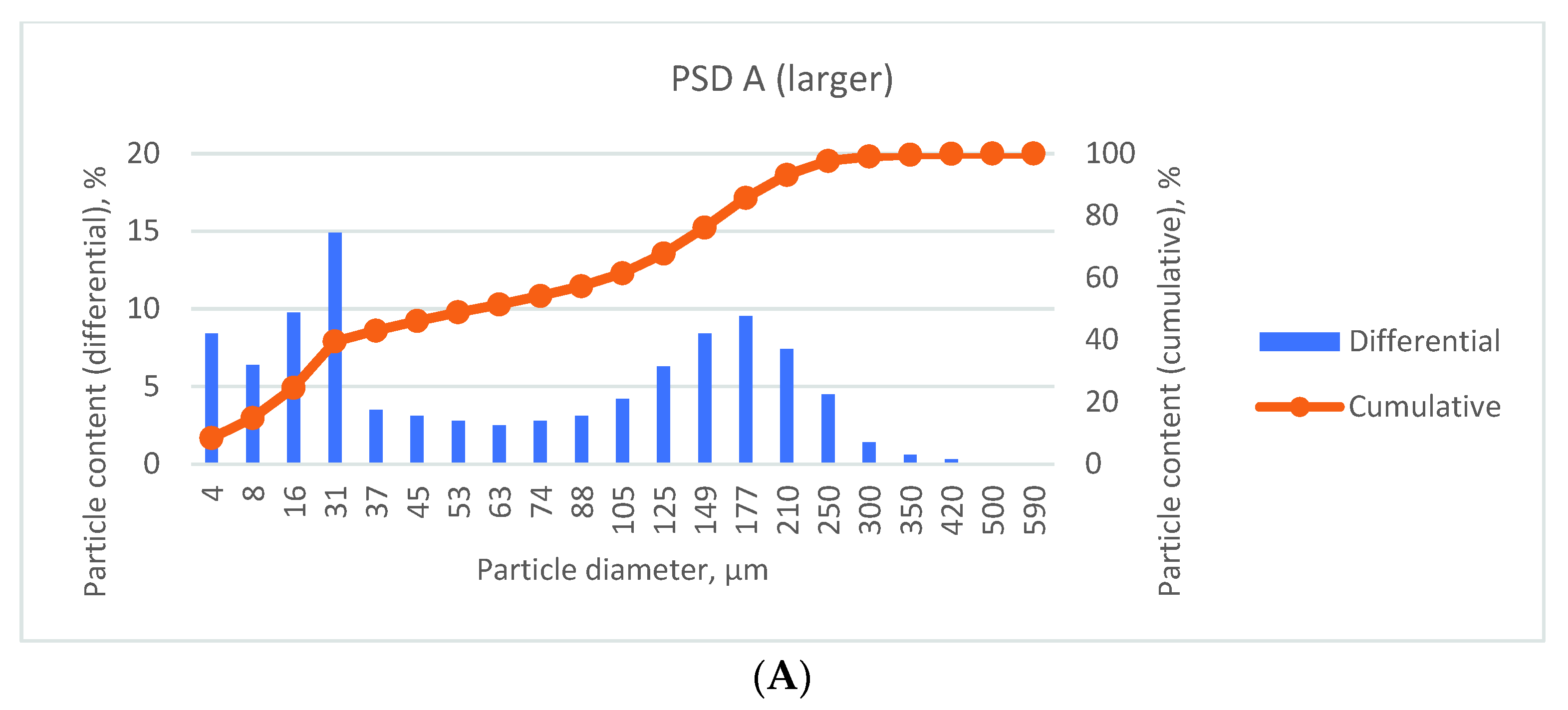
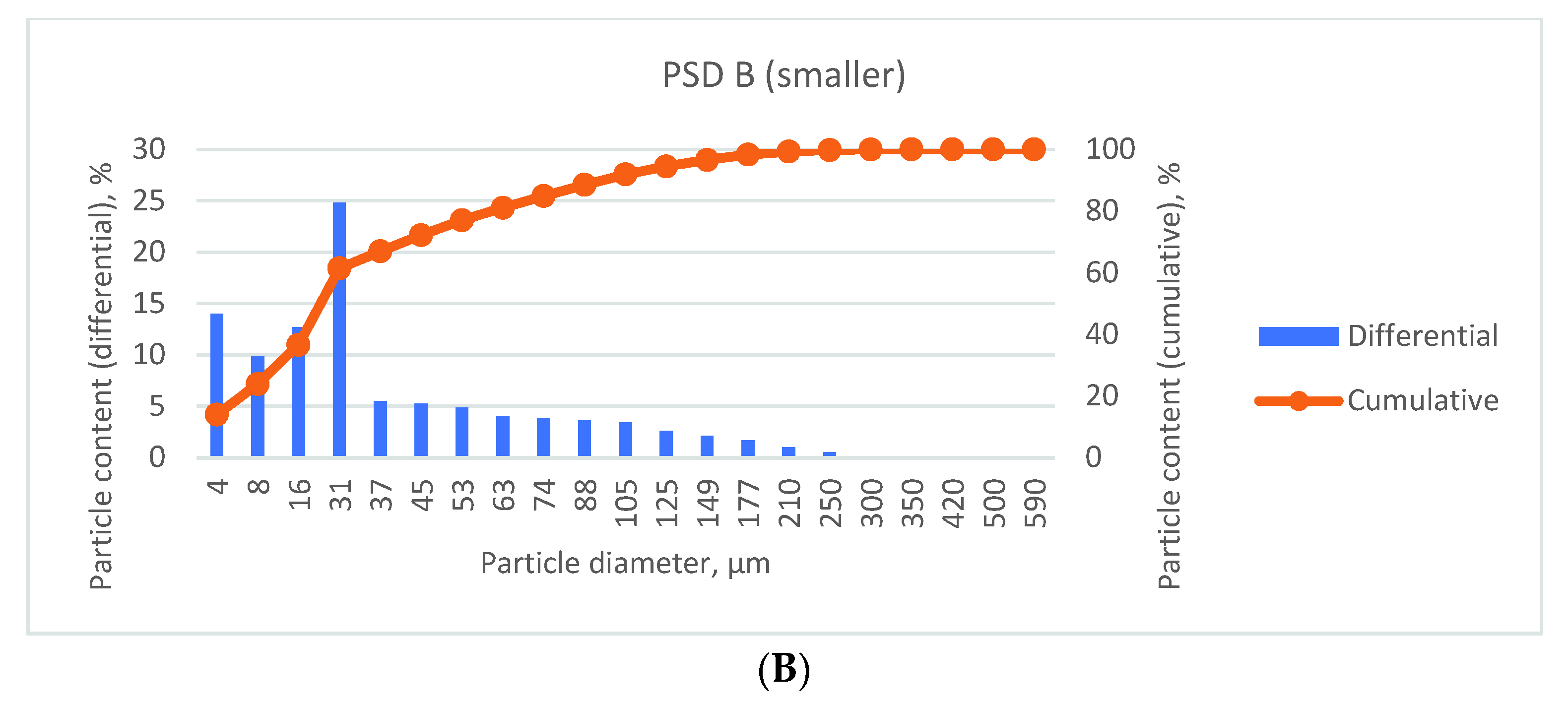
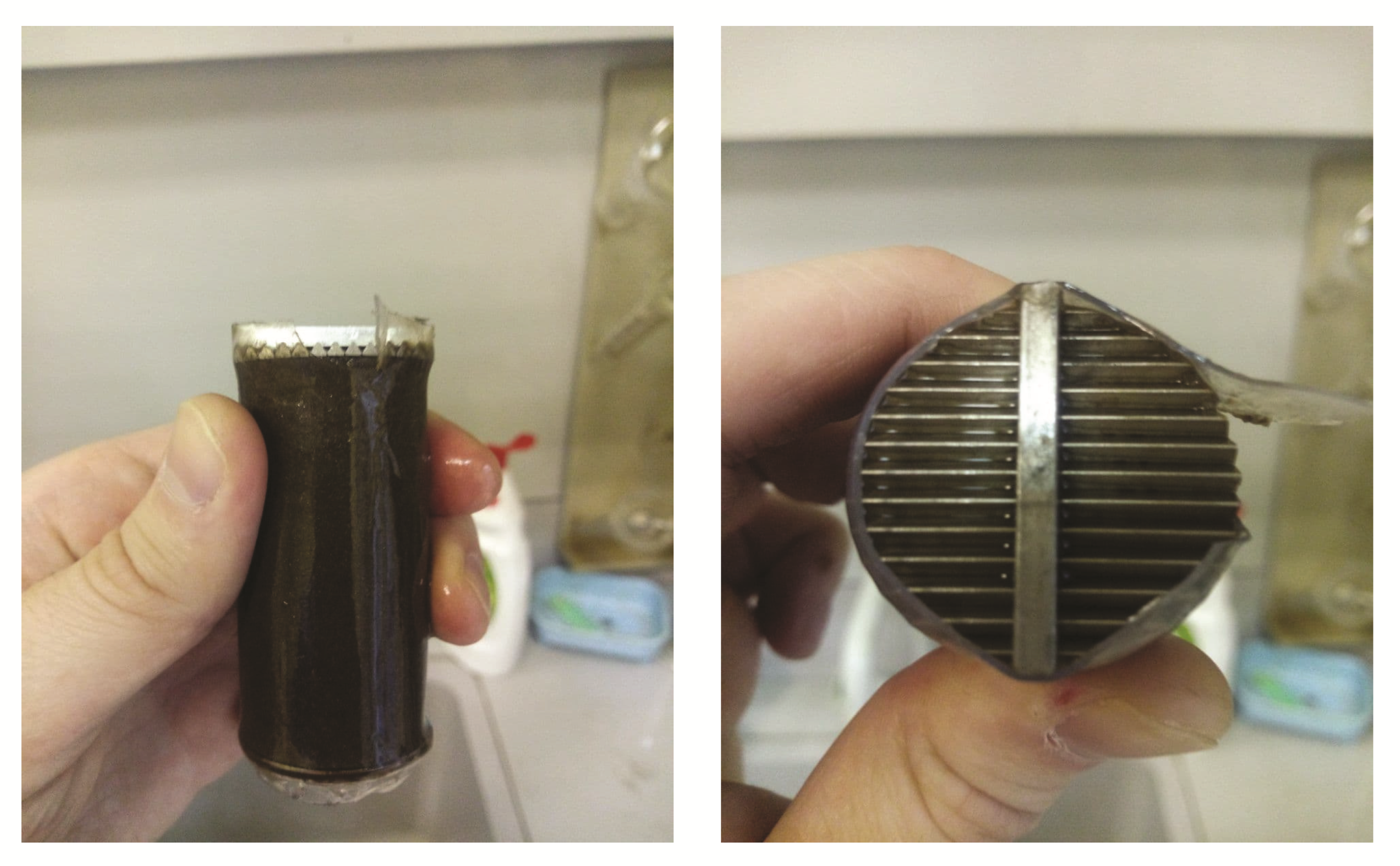

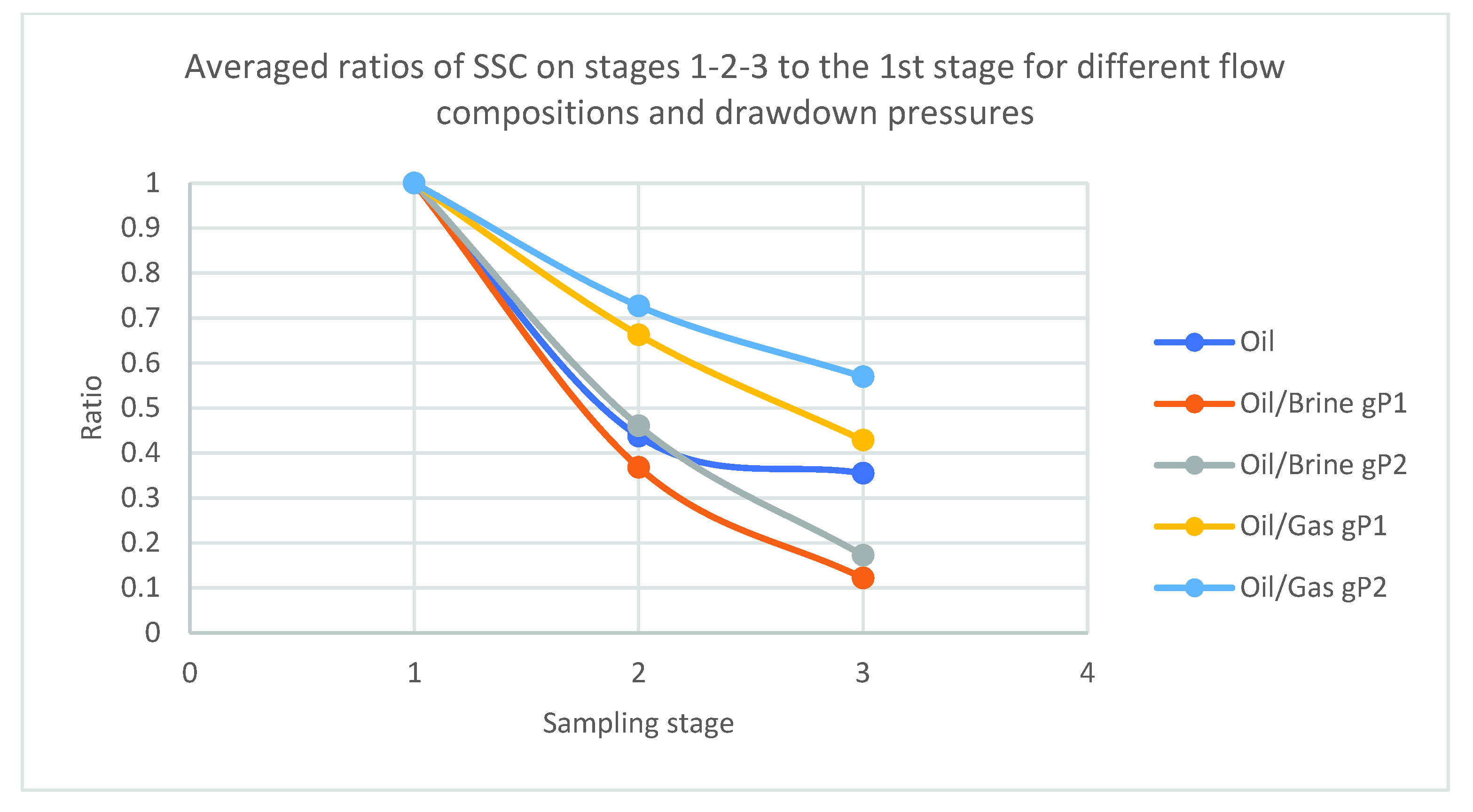
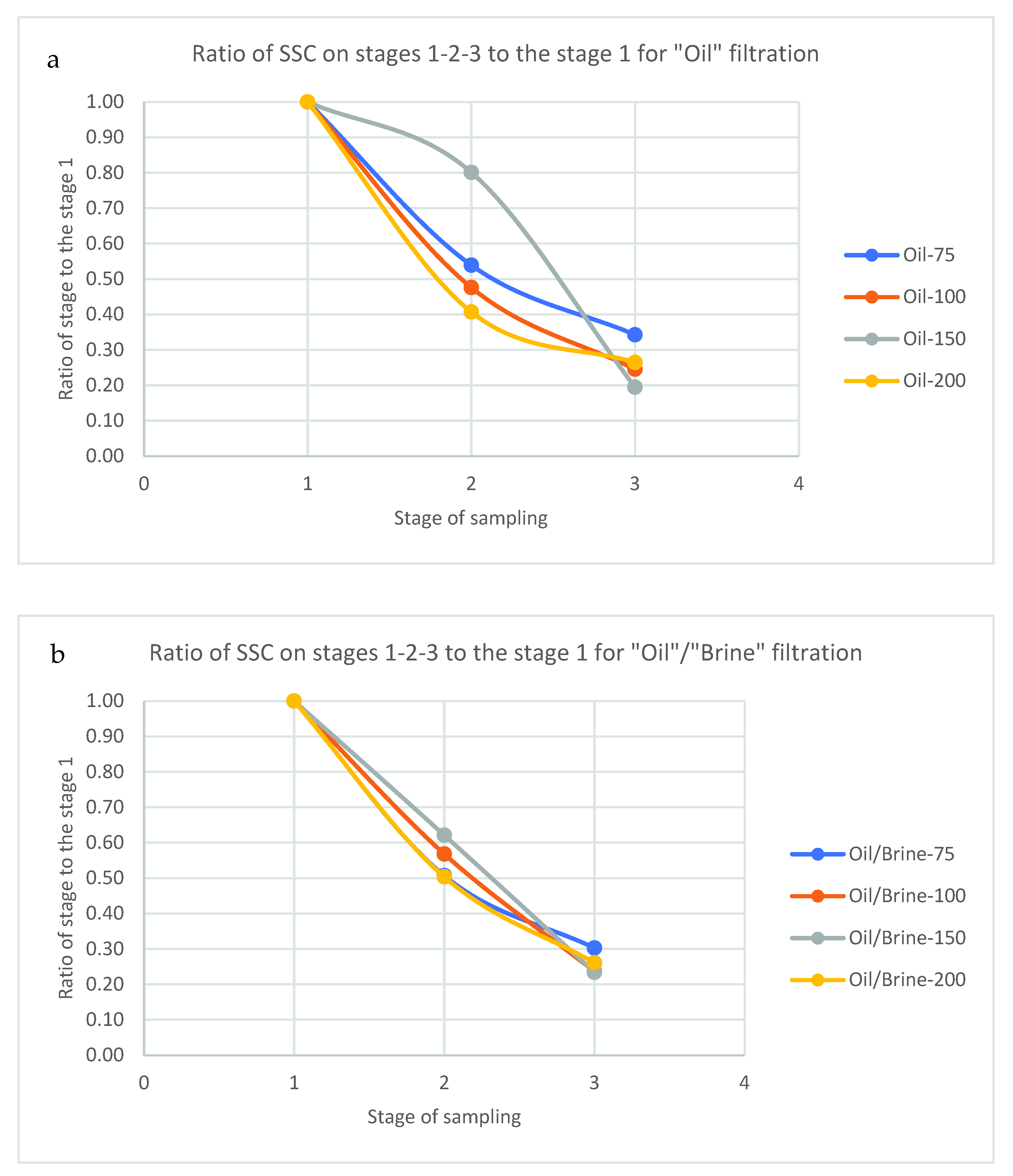
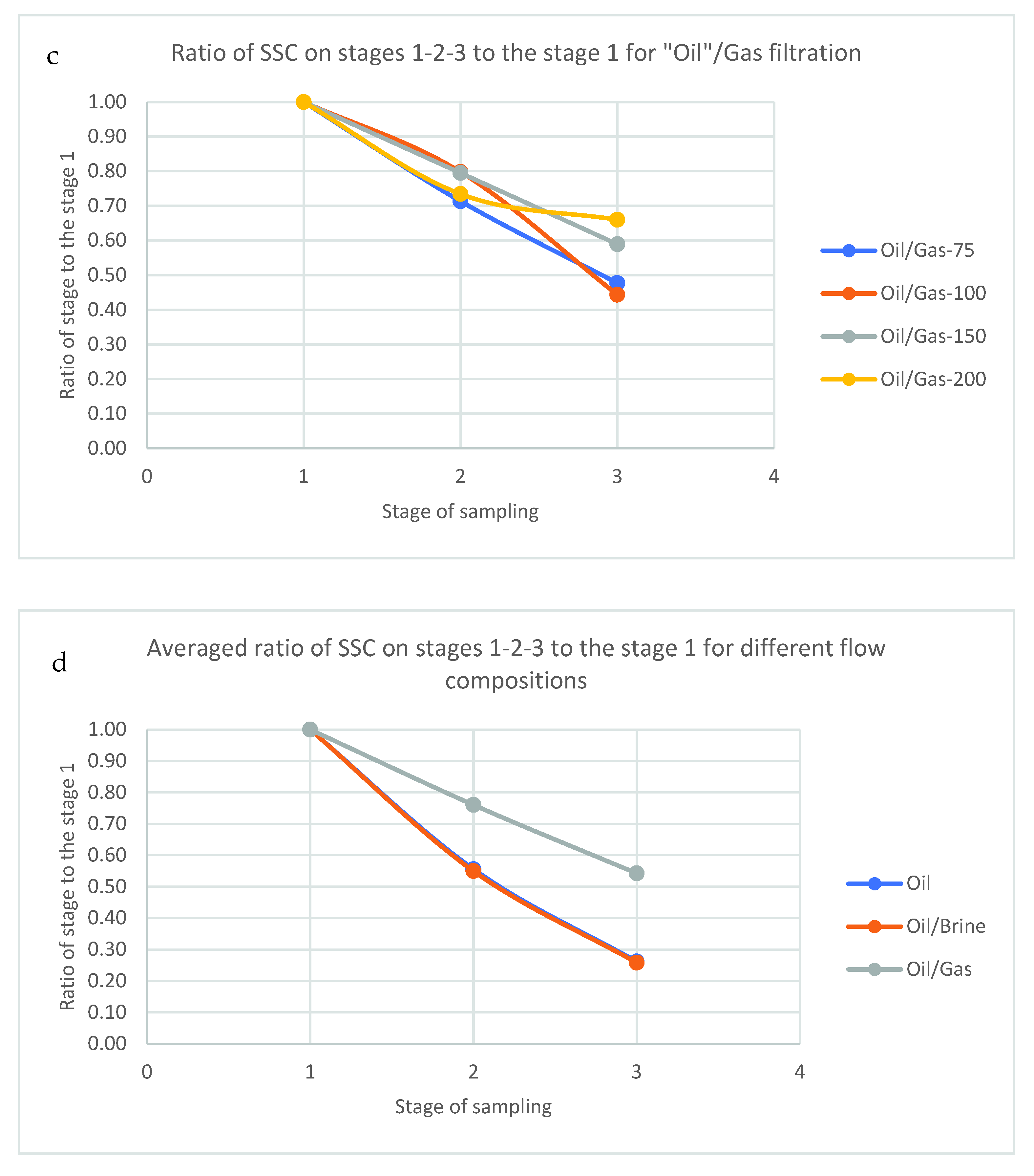


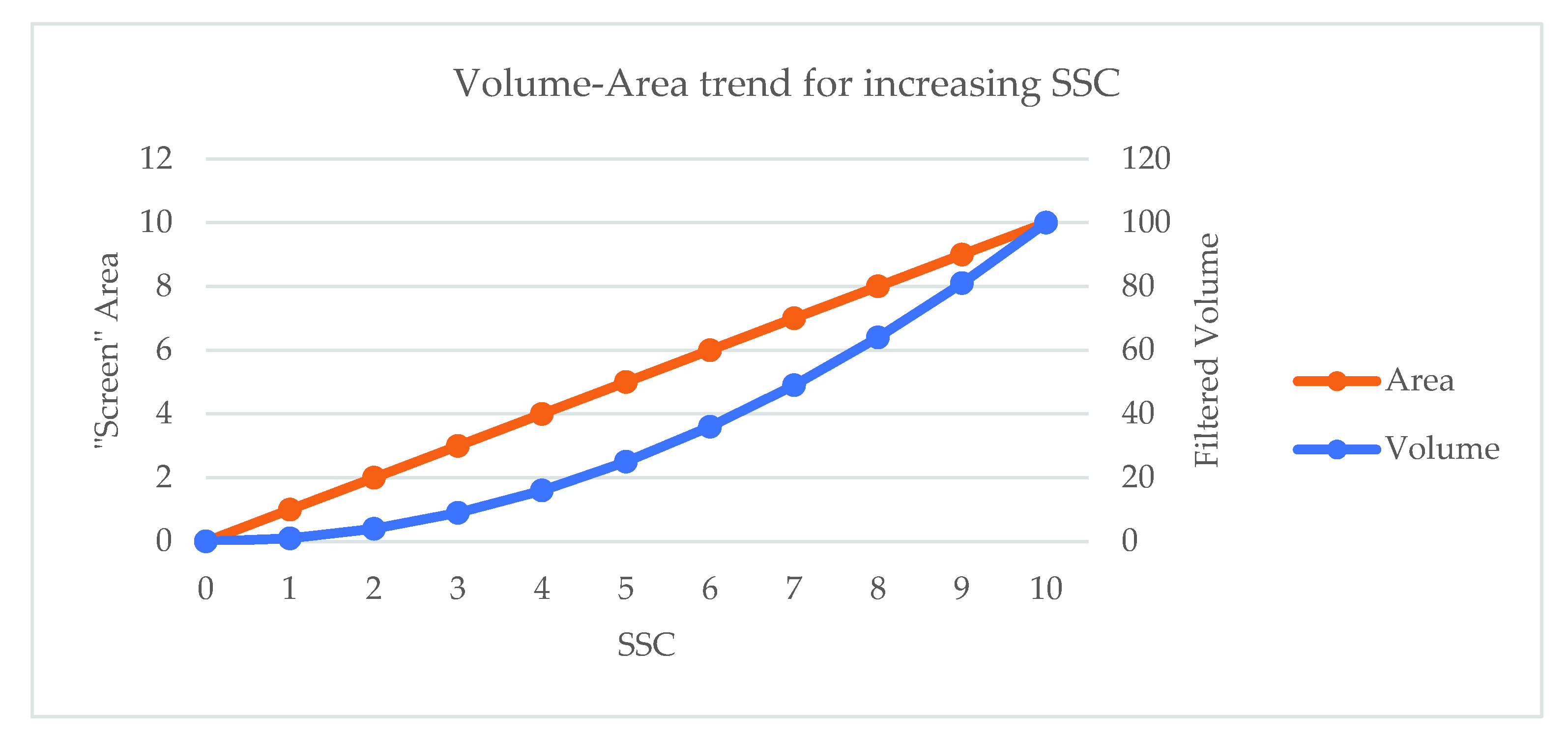
| Screen Aperture | Drawdown Pressure | “Oil” | “Oil”/Brine | “Oil”/Gas | ||||
|---|---|---|---|---|---|---|---|---|
| µm | - | 100% | 90/10 | 50/50 | 30/70 | 70/30 | 50/50 | 10/90 |
| 100 | gradP1 | 4.3 | 6.5 | 7.9 | ||||
| 150 | 6.7 | 5.3 | 4.4 | |||||
| 200 | 8.5 | 10.8 | 11.5 | 14.5 | 7.3 | 5.6 | 4.4 | |
| 500 | 11.9 | 78.4 | 87 | 336.6 | 422 | |||
| 700 | 18.2 | 180 | 430 | |||||
| 100 | gradP2 | 19 | 11 | 14.4 | 16.6 | |||
| 150 | 14 | 11.9 | 7.4 | |||||
| 200 | 29.6 | 15.4 | 18.5 | 21.7 | 18.3 | 13.8 | 9.1 | |
| 500 | 34 | 268.4 | ||||||
| 700 | 733 | |||||||
| Screen Aperture | Drawdown Pressure | “Oil” | “Oil”/Brine | “Oil”/Gas | ||||
|---|---|---|---|---|---|---|---|---|
| µm | - | 100% | 90/10 | 50/50 | 30/70 | 70/30 | 50/50 | 10/90 |
| 75 | gradP2 | 3.23 | 3.50 | 3.77 | 4.01 | 3.17 | 2.80 | 3.29 |
| 100 | 4.75 | 5.80 | 7.11 | 7.56 | 4.60 | 4.97 | 5.10 | |
| 150 | 7.41 | 7.92 | 9.09 | 11.18 | 7.45 | 7.61 | 7.79 | |
| 200 | 10.92 | 17.16 | 15.07 | 12.83 | 9.65 | 10.86 | 13.17 | |
| Screen Aperture Size | Drawdown Pressure | “Oil” | “Oil”/Water | “Oil”/Gas | ||||
|---|---|---|---|---|---|---|---|---|
| µm | - | 100 | 3/7 | 5/5 | 9/1 | 3/7 | 5/5 | 1/9 |
| 100 | gradP1 | - | 95 | 87 | 94 | - | - | - |
| 150 | gradP1 | - | - | - | - | 96 | 96 | 99 |
| 200 | gradP1 | 87 | 93 | 98 | 97 | 98 | 94 | 99 |
| 100 | gradP2 | 94 | 87 | 69 | 92 | - | - | - |
| 150 | gradP2 | - | - | - | - | 98 | 92 | 98 |
| 200 | gradP2 | 98 | 82 | 78 | 97 | 98 | 96 | 95 |
Publisher’s Note: MDPI stays neutral with regard to jurisdictional claims in published maps and institutional affiliations. |
© 2022 by the authors. Licensee MDPI, Basel, Switzerland. This article is an open access article distributed under the terms and conditions of the Creative Commons Attribution (CC BY) license (https://creativecommons.org/licenses/by/4.0/).
Share and Cite
Tananykhin, D.; Grigorev, M.; Korolev, M.; Solovyev, T.; Mikhailov, N.; Nesterov, M. Experimental Evaluation of the Multiphase Flow Effect on Sand Production Process: Prepack Sand Retention Testing Results. Energies 2022, 15, 4657. https://doi.org/10.3390/en15134657
Tananykhin D, Grigorev M, Korolev M, Solovyev T, Mikhailov N, Nesterov M. Experimental Evaluation of the Multiphase Flow Effect on Sand Production Process: Prepack Sand Retention Testing Results. Energies. 2022; 15(13):4657. https://doi.org/10.3390/en15134657
Chicago/Turabian StyleTananykhin, Dmitry, Maxim Grigorev, Maxim Korolev, Timur Solovyev, Nikolay Mikhailov, and Mark Nesterov. 2022. "Experimental Evaluation of the Multiphase Flow Effect on Sand Production Process: Prepack Sand Retention Testing Results" Energies 15, no. 13: 4657. https://doi.org/10.3390/en15134657





